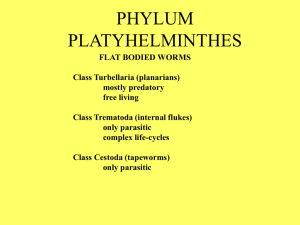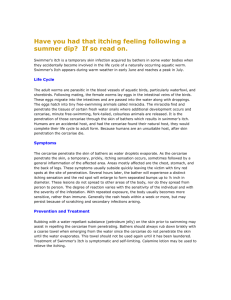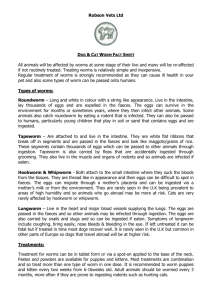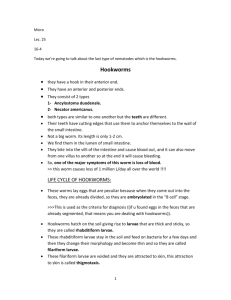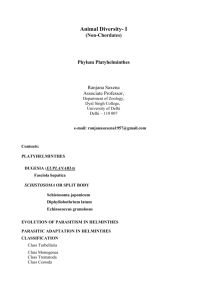Phylum Platyhelminthes
advertisement
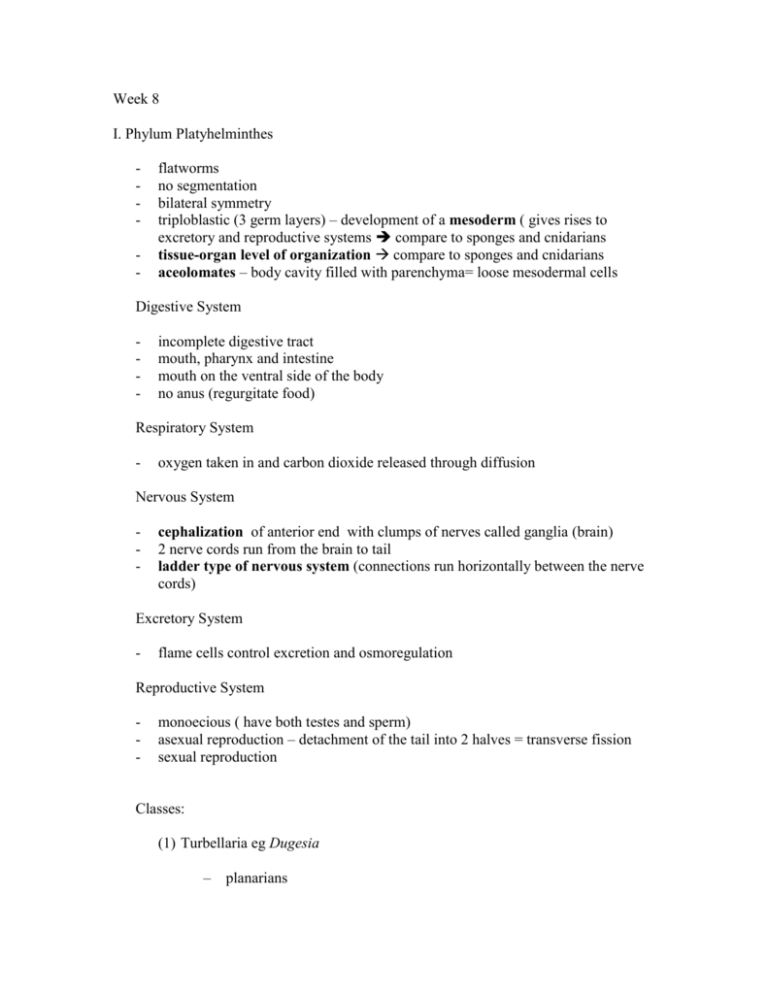
Week 8 I. Phylum Platyhelminthes - flatworms no segmentation bilateral symmetry triploblastic (3 germ layers) – development of a mesoderm ( gives rises to excretory and reproductive systems compare to sponges and cnidarians tissue-organ level of organization compare to sponges and cnidarians aceolomates – body cavity filled with parenchyma= loose mesodermal cells Digestive System - incomplete digestive tract mouth, pharynx and intestine mouth on the ventral side of the body no anus (regurgitate food) Respiratory System - oxygen taken in and carbon dioxide released through diffusion Nervous System - cephalization of anterior end with clumps of nerves called ganglia (brain) 2 nerve cords run from the brain to tail ladder type of nervous system (connections run horizontally between the nerve cords) Excretory System - flame cells control excretion and osmoregulation Reproductive System - monoecious ( have both testes and sperm) asexual reproduction – detachment of the tail into 2 halves = transverse fission sexual reproduction Classes: (1) Turbellaria eg Dugesia – planarians – – – – – free living ciliated epidermis for movement have ocelli = eyespots for the detection of light which they move away from have auricles which are tactile and olfactory in function regeneration possible http://dragon.seowon.ac.kr/~bioedu/bio/ohp/t-162.jpg http://cas.bellarmine.edu/tietjen/images/platyhelminthes.htm http://cas.bellarmine.edu/tietjen/images/platyhelminthes.htm (2) Monogena eg Polystoma – – – – flukes parasitic common on the skin or gills of fish no asexual reproduction (3) Trematoda eg Clonorchis, Schistosoma – – – flukes parasitic (endoparasites – live inside the host and ectoparasites – live on the surface of the host) tissue and blood flukes Chlonorchis Life Cycle www.dpd.cdc.gov/.../ body_Clonorchiasis_page1.htm - several hosts involved in life cycle eggs are released from the host in the feces eggs hatch into free-swimming forms (miracidia) when they reach water miracidia enter a snail or other mollusk (intermediate host) and become sporocysts cells of the sporocysts undergo mitosis forming rediae rediae give rise to free-swimming cercariae that escape from the mollusk into water cercariae penetrate another host, usually an arthropod using enzymes the penetrated cercariae encyst forming metacercariae when the arthropod is eaten by the definitive host (human), the metacercariae excyst and develop into eggs repetition of the cycle Schistosoma Life Cycle www.drnatura.com/ parasites.html - - - similar life cycle to Chlonoris eggs are released in water either from the urine or feces depending on the strain eggs hatch hatch into free-swimming forms (miracidia) miracidia enters a snail and become sporocysts cells of the sporocysts undergo mitosis producing cercariae cercariae are released into water from the snail penetration of the skin of the human host by the cercaria which secretes enzymes that break down the skin's proteins enabling penetration of the cercaria through the skin transformation of the cercariae into a migrating schistosumula stage schistosomula travels through the blood to the lungs where it undergoes further developmental changes before it migrates to the liver the worms pair and then move either to the mesenteric or rectal veins onece mature enough (~ 6-8 weeks after invasion) they produce eggs the eggs pass through the walls of the blood vessels, and through the intestinal wall and are released from the body in the faeces (S japonicum and S. mansoni) or the eggs pass through the bladder wall and into the urine (S. haematobium) Schistosomiasis (Bilharzia) o eggs trapped in the body mature and begin secreting antigens o these antigens elicit a violent immune response (4) Cestoda eg Taenia, Diphyllobrothium - tapeworms - parasitic - live in the digestive tract of vertebrates – adult form - no digestive tract or mouth - scolex (with hooks) used for attachment to the intestine of the host - neck divides to form new proglottids - proglottids contain the reproductive structures - flame cells (protonephridia) used for excretion - gravid proglottids (mature) leave the host via the feces Taenia Life Cycle http://www.dpd.cdc.gov/dpdx/HTML/Taeniasis.asp?body=Frames/S-Z/Taeniasis/body_Taeniasis_page1.htm - - pigs may contain cysticerci embedded in their muscles by eating contaminated vegetation oncospheres hatch in the pig’s intestine and then migrate to the muscles where they become cysticerci cysticerci are ingested by humans eating undercooked meat (pork/beef) cysticerci consist of a capsule containing a scolex. upon ingestion of the worm, the gastric juice in the stomach dissolves the wall of the capsule and the scolex turns inside out and attaches by suckers and hooks to the wall of the intestine proglottids are then produced from the scolex and remain attached as they mature developing both male and female sex organs in each gravid (mature) proglottids break off and are passed out in the feces, each containing the fertilized eggs life cycle repeats itself http://cas.bellarmine.edu/tietjen/images/platyhelminthes.htm II. Phylum Nematoda (nematode = thread) - roundworms psuedoceolumates no cilia bilateral symmetry triplobalstic tissue-organ level of organization long, narrow cylindrical body tapered at both ends virtually no head epidermis secretes a thick, tough yet flexible cuticle - cuticle protects the worm from drying out or being crushed cuticle is shed as the organism matures (~ 4 times before reaching the adult stage) = molting longitudinal muscles allow to bend from side to side, appears to thrash from side to side (no circular muscles) parasitic or free-living Digestive System - complete digestive tract mouth anus Respiratory System - oxygen taken in and carbon dioxide released through diffusion Nervous System - ring of nerve tissue around the pharynx gives rise to 2 nerves (dorsal and ventral) that run along the length of the body Excretory System - no flame cells Reproductive System - most are dioecious males are smaller than females sexual reproduction = copulation male attaches to the female by copulatory spines and injects the sperm into the genital pore sperm lack flagella but move by pseudopodia Ascarias Life Cycle http://www.infovek.sk/predmety/biologia/metodicke/hlistovce/obrazky/AscariasisLifeCycle.gif - adult worms live in the small intestine eggs are passed with the feces eggs become infective after 18 days to several weeks depending on the environmental conditions (moist, warm, shaded soil). when eggs are swallowed, larvae hatch larvae invade the intestinal mucosa from the intestine they are and are carried via the portal circulation, then systemic circulation to the lungs larvae mature in the lungs (10-14 days) larvae penetrate the alveoli - from the alveoli they move up the bronchial tree into the throat where they are swallowed and return to the small intestine and mature into adults III Phylum Annelida - segmented worms earthworms, leeches and polychaetes triploblastic ceolomates – body wall is divided into compartments by septa circular and longitudinal muscles cuticle secreted by the epithelial cells all have setae (except leeches) – hair-like structures made of chitin setae can be located on parapodia (appendages) Segmentation = metamerism (characteristic feature of annelids) - each segment contains elements of the circulatory, nervous, and excretory tracts. - increases the efficiency of body movement by allowing the effect of muscle contraction to be extremely localized Digestive System - complete mouth anus Respiratory System - gas exchange through the skin or specialized gills or modified parapodia Circulatory System - closed Nervous System - a pair of cephalic ganglia attached to double nerve cords that run the length of the animal along the ventral body wall there are ganglia and branches in each segment. tactile organs, chemoreceptors, balance receptors, and photoreceptors some have well developed eyes, including lenses. Reproductive System - monoecious or dioecious asexual reproduction = fission (posterior part of the body breaks off and forms a new individual) - sexual reproduction = copulation Two worms attracted by each other's secretions lay together with their heads pointing opposite directions and fluid is transferred from the male pore to the female worm. Classes: (1) Polycheata http://www.mytobago.info/photos/diving/hazards/bristle-worm.jpg - bristleworms - marine - have parapodia (vascularized) used for movement and gas exchange - well developed heads (2) Oligocheata http://www.bu.edu/lernet/GK12/eric/earthworm.jpg - earthworms - freshwater and terrestrial - hermaphroditic - no appendages/parapodia - few setae - spacious coelom used as a hydrostatic skeleton - external fertilization - no trocophore larvae stage (3) Hirudenia http://en.wikipedia.org/wiki/Leech - leeches - freshwater, terrestrial and marine - all are carnivorous - some are predatory - feed on blood - hermaphroditic - no appendages/parapodia - ventral sucker formed from the last 6 segments of the body used to connect to a host for feeding - release an anesthetic to make host unaware of their presence - secrete an anti-clotting enzyme into the blood of the host

